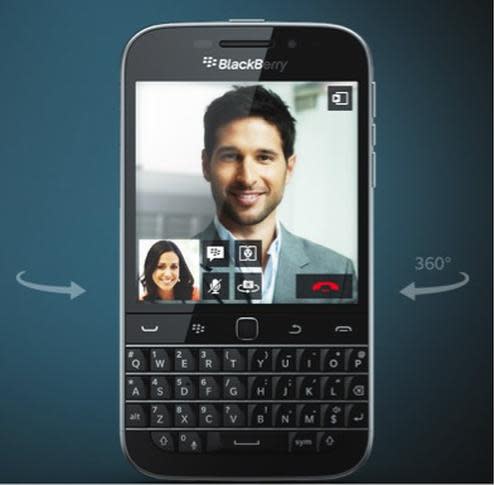A look at the BlackBerry Classic

Image: us.blackberry.com
The Classic is a new smartphone. It sports a dual-core 1.5 Ghz processor, 2 Gb of RAM, a 3.5" 720x720 touch screen, 16 Gb of storage (more can be added via a micro-SD card slot; up to 144 Gb, in fact), an 8 MP rear camera/ 2 MP front camera, and 22 hours of life via a 2515 mAh battery (I've always found battery life more impressive on BlackBerries than the competition, but the drawback here is that the battery is non-removable). The Classic runs the BlackBerry 10.3.1 OS, the latest version which has been designed to take advantage of multi-CPU cores. Pricing runs about $450.
Big deal, right? Androids and Apple iPhones have bigger screens, comparable cameras and just as much storage, not to mention plenty of zippy CPU power, right? Well, there is a new element afoot in the BlackBerry Classic: it can run BlackBerry and Android apps (from the Amazon Appstore), closing a significant gap in quality and availability between the two - at least from what I've observed in the past, whereby modern apps are difficult to find in BlackBerry World, BlackBerry's app delivery environment.
If form factor and responsive key input are important to you, I've found BlackBerry to consistently come out on top of these fields. The models I owned always fit my palm perfectly. I have an awful time with touchscreen keys, perhaps due to my poor fingertip circulation, and so I get along better with a physical keyboard. I don't actively use a BlackBerry now for email, but I miss doing so since I could bang out a paragraph in a third of the time it takes me now with an Android (yes, I've tried Swype).
You might argue the web browser on the BlackBerry is a show-stopper and has been for some time. I won't disagree the older models left a lot to be desired when it came to web browsing, but BlackBerry claims the browser that shops with BlackBerry 10 is three times as fast as on prior models, and "HTML5TEST.com has rated it amongst the top mobile browsers for web fidelity for 2 years in a row." It's clear they've addressed a significant problem.
One of the reasons BlackBerry slid so far from their promontory wasn't so much because the devices were poor, but that for some time they owned the bulk of the mobile management space. Their BlackBerry Enterprise Server product made it easy to provision, deploy and manage devices with a plethora of security and administrative controls, helping IT shops crank out mobile devices to users in assembly-line fashion. This product still exists (Simon Bisson covers BlackBerry Enterprise Server 12 this month on our affiliated Tech Pro Research site) and can support multiple device types including non-BlackBerry products. However, since the rise of Activesync and other communication protocols, not to mention the explosion of BYOD, BlackBerry's mobile management strategies have taken a back seat thus facilitating the company's decline.
To be blunt, I found many of the BlackBerry Enterprise Server features unnecessary (who really wants to disable a camera or block a web browser?) and wasn't surprised that many other shops did, too. In many cases enforcing the use of a password and ensuring devices are wiped after X failed logon attempts are sufficient security measures and this is possible through alternative means such as Microsoft Exchange controls. So, ever since BlackBerry lost the edge on device management, the devices themselves have to be compelling and innovative enough to keep BlackBerry in the pool.
That innovation part is tricky; it has been for some time across all tech industries and the need is only likely to get stronger as we expect more and more out of our personal technology. Innovation means doing something new that others can't pull off. The Classic is a worthy upgrade to prior BlackBerry models with a compelling round of features - I would easily buy it for my users if I worked on a shop dictating centralized mobile device deployment and management - but it isn't particularly innovative. The small screen and the non-removable battery (I can't fathom why BlackBerry considered that an improvement) will hamstring it. Quite likely it will appeal only to those already committed to the BlackBerry platform; the shops that don't permit BYOD (for security or support purposes) or those who genuinely prefer the BlackBerry product line over the alternatives.
In short, the Classic is a niche product appealing only to a dedicated few, like vinyl records. However, that may well be good enough for the corporate subset to earn BlackBerry enough revenue to keep them going through 2015. If nothing else, they serve as a wake-up call to the smartphone leaders that "Hey, we're still here, and we can crank out good hardware too."
Whether you like BlackBerry, ridicule it, or don't even think about it at all, we can probably all agree that the more players there are in the smartphone space means the more choices we'll have - and plenty of reminders to the top dogs not to take their clientele for granted, nor to rest on their haunches and allow mediocre products out the door.

